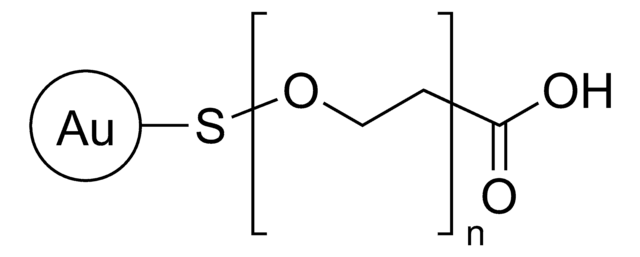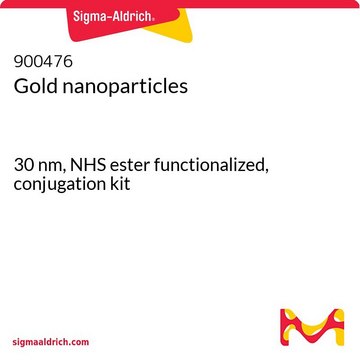Wichtige Dokumente
765554
Gold nanoparticles
40 nm diameter, carboxylic acid functionalized, PEG 3000 coated, OD 50, dispersion in H2O
Synonym(e):
Gold nanoparticles COOH functionalized, Au NP COOH, Gold Colloid
About This Item
Empfohlene Produkte
Materialien
PEG 3000
Form
dispersion in H2O
nanoparticles
Verpackung
poly bottle of 1 mL
OD
50
Durchmesser
40 nm
pH-Wert
6.0-8.0 (25 °C)
Löslichkeit
water: miscible
Dichte
1.00 g/cm3
λmax
530 nm
Funktionelle Gruppe
carboxylic acid
Lagertemp.
2-8°C
Suchen Sie nach ähnlichen Produkten? Aufrufen Leitfaden zum Produktvergleich
Allgemeine Beschreibung
Anwendung
- Since they adhere to cell membranes, AuNPs may find use in cellular and intracellular targeting in targeted drug delivery applications and may also be used in biodistribution studies.
- AuNPs may also be used in photothermal therapy and radiotherapy.
- AuNPs ranging from 10 to 250 nm, were studied to have been absorbed primarily by liver and spleen, when injected intravenously in rats.Whereas, 10 nm nanoparticles were distributed more broadly into various organs.
- Carboxylic acid end-groups bind with various proteins and hence are used in targeted drug delivery and gene therapy.
Leistungsmerkmale und Vorteile
Lagerklassenschlüssel
12 - Non Combustible Liquids
WGK
WGK 1
Flammpunkt (°F)
Not applicable
Flammpunkt (°C)
Not applicable
Hier finden Sie alle aktuellen Versionen:
Analysenzertifikate (COA)
Die passende Version wird nicht angezeigt?
Wenn Sie eine bestimmte Version benötigen, können Sie anhand der Lot- oder Chargennummer nach einem spezifischen Zertifikat suchen.
Besitzen Sie dieses Produkt bereits?
In der Dokumentenbibliothek finden Sie die Dokumentation zu den Produkten, die Sie kürzlich erworben haben.
Artikel
The recent emergence of a number of highly functional nanomaterials has enabled new approaches to the understanding, diagnosis, and treatment of cancer.
Biomaterials science involves the design and fabrication of smart materials for studying, directing, or mimicking biology. For successful integration of biomaterials in biological research, a meaningful understanding of biological systems is required.
Unser Team von Wissenschaftlern verfügt über Erfahrung in allen Forschungsbereichen einschließlich Life Science, Materialwissenschaften, chemischer Synthese, Chromatographie, Analytik und vielen mehr..
Setzen Sie sich mit dem technischen Dienst in Verbindung.




